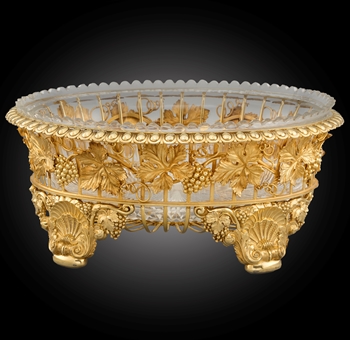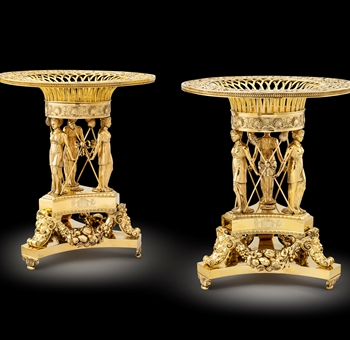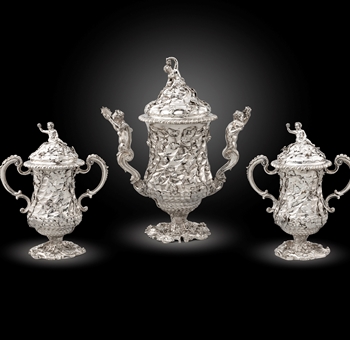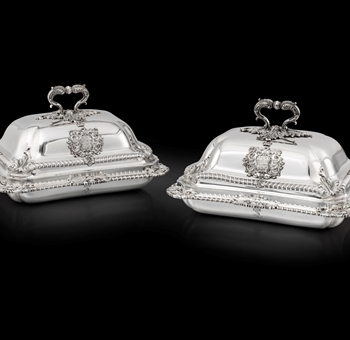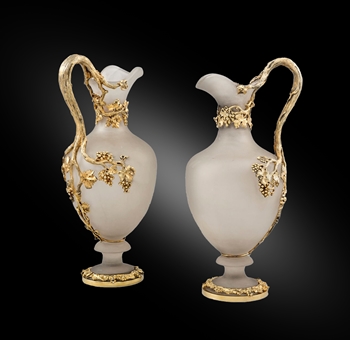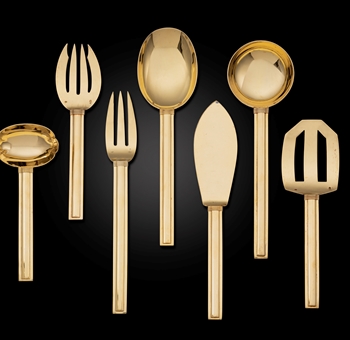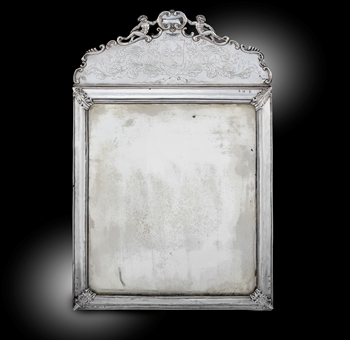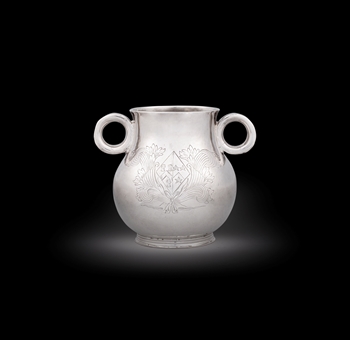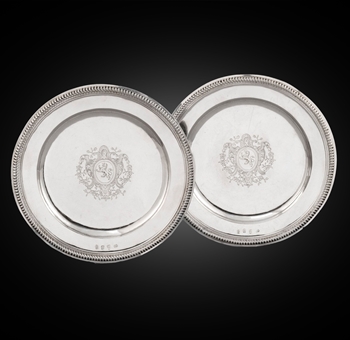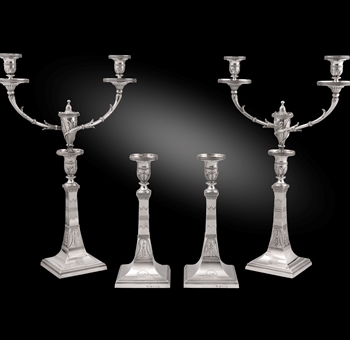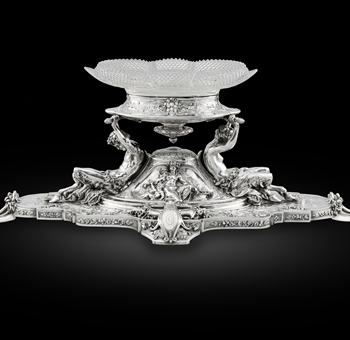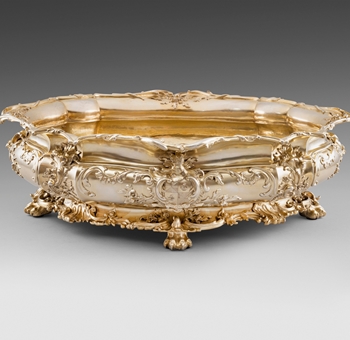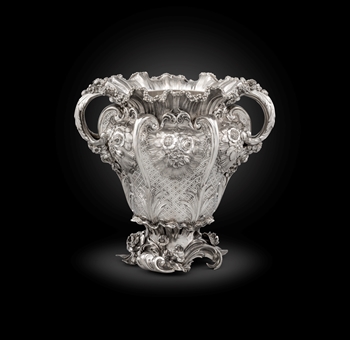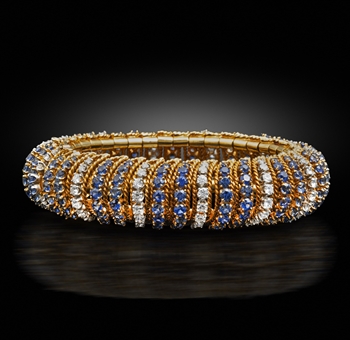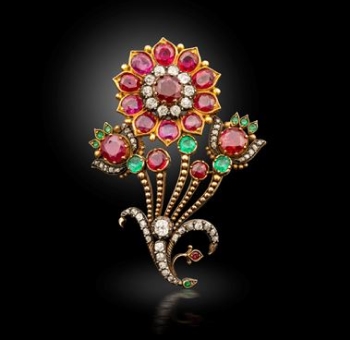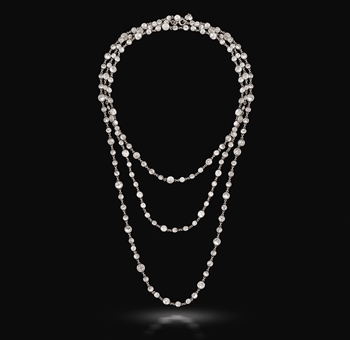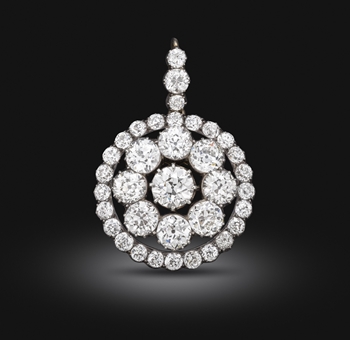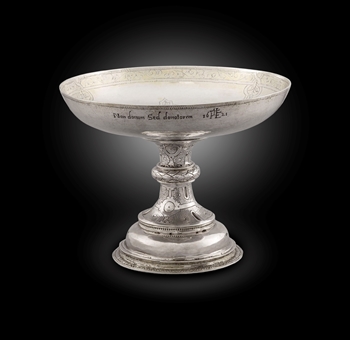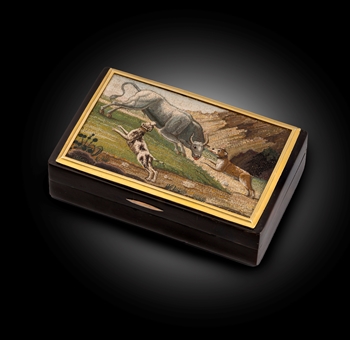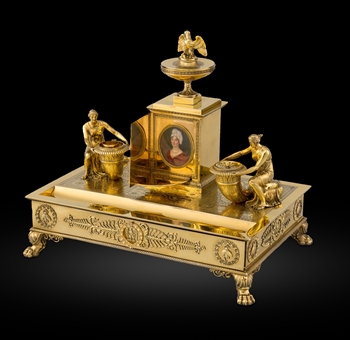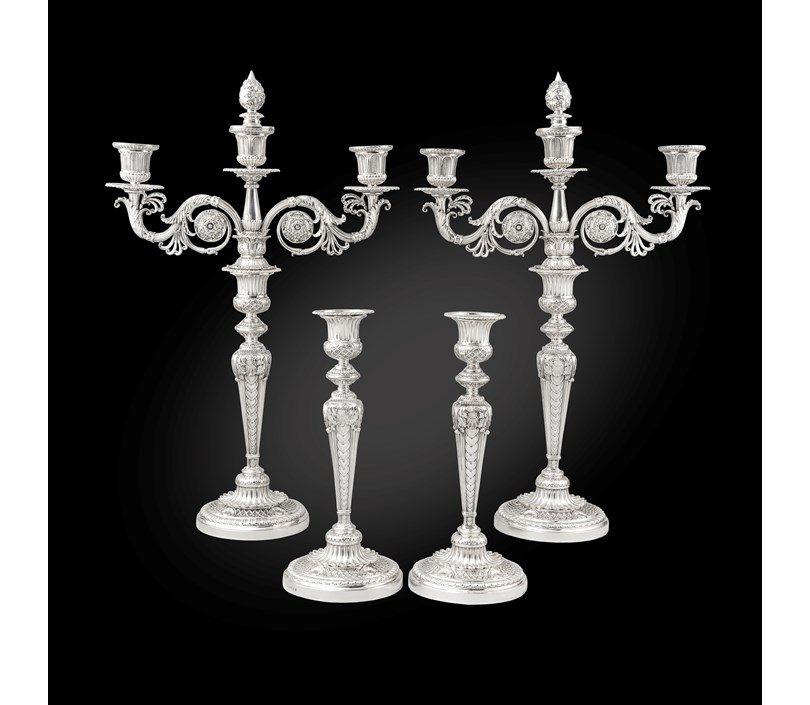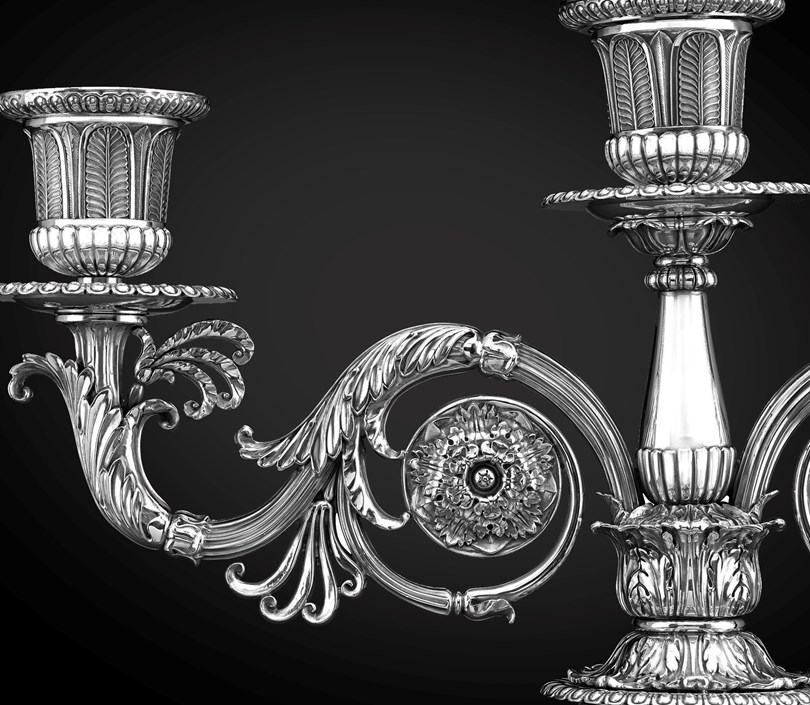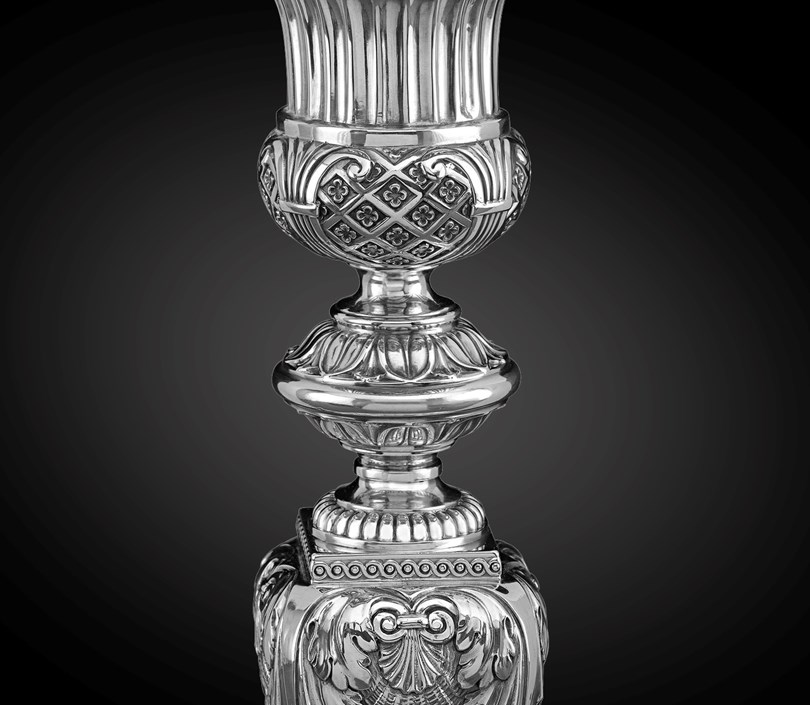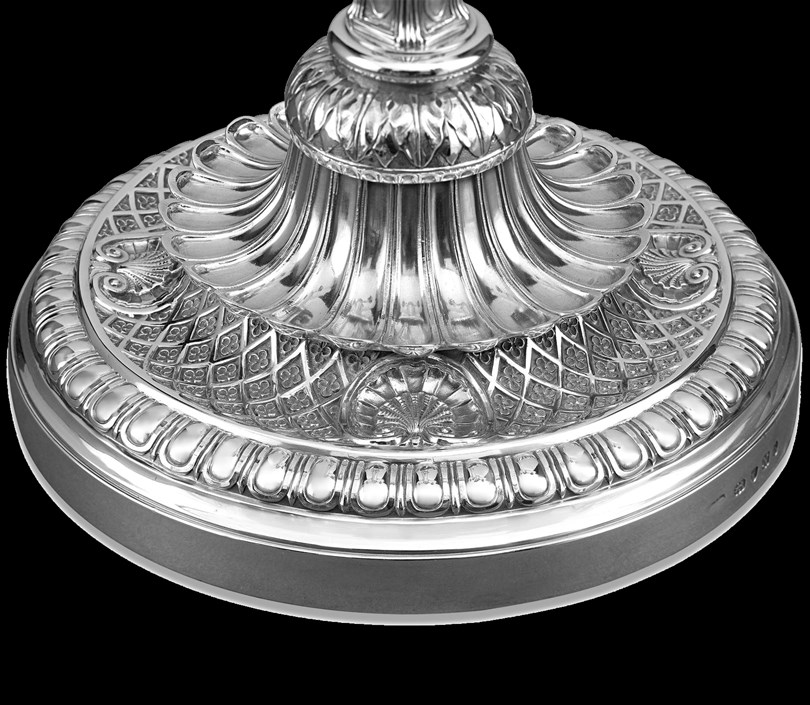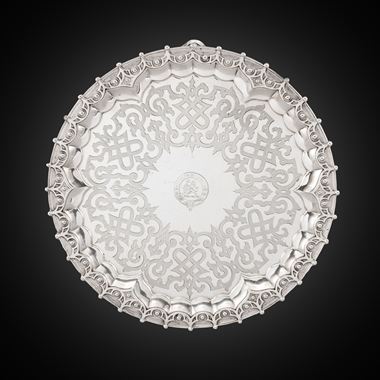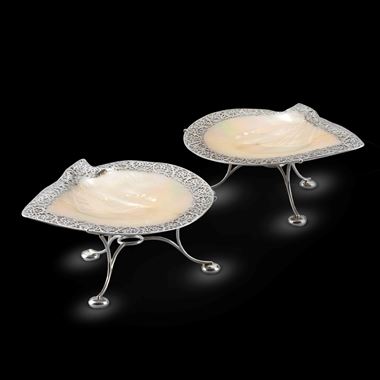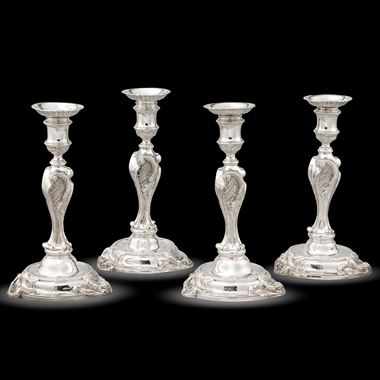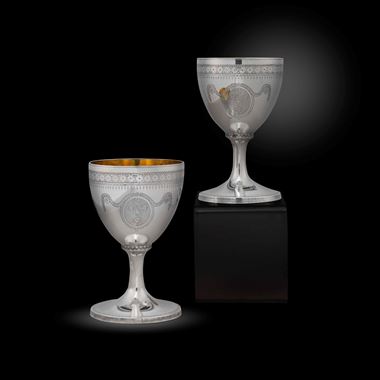This significant set of candelabra and candlesticks by legendary English silversmith Paul Storr is perhaps the finest he ever created. Crafted for the firm Rundell, Bridge and Rundell, they reflect the remarkable sculptural quality of Storr's most significant works; it was a style informed by the age, demonstrating the pride and prosperity of Britain following the Napoleonic wars. This four-piece set represents the highest quality and artistry of Storr's output from the period. The sculptural qualities of silver were exploited by Storr and the famed retail firm, who created not only works for the table but also great displays for the buffet.
Without question, this spectacular set is among the most coveted works crafted by this gifted silversmith. Designed with a vibrant trelliswork motif, they display the artful balance of classical and French Huguenot Baroque influences that was Storr's signature. A very similar set was formerly in the collection of the Dukes of Bedford at Woburn Abbey.
Paul Storr is undoubtedly considered among history's finest smiths and is known for perfecting the works, styles and designs of the Regency period. Though he held no formal title, Storr enjoyed patronage from the most important and influential figures of the period, including King George III and the Prince of Wales, the future King George IV. Many of Storr's successes were partly due to the influence of Philip Rundell, the famous silver retailing firm of Rundell, Bridge and Rundell. Rundell's firm nearly monopolized the early 19th-century market for fine silver, having obtained the Royal Warrant in 1806. Rundell recognized the unique talents of Paul Storr and began pursuing him in 1803, but it was not until after declining many offers that Storr finally joined the firm in 1806. Due to his remarkable talents, Storr was allowed to retain his own mark while working for Rundell, a remarkable show of esteem from the retailers.
Storr imparted a level of craftsmanship and superior quality that has seldom been seen since. Today, his creations are highly regarded and collected by museums and silver connoisseurs around the world.
Each on a circular base with tongue-and-dart border and foliate diaper work with shells at intervals, the fluted base supporting a tapering square stem with lappet band and shell and acanthus shoulder, the fluted campana-form socket with conforming foliate diaper work, the detachable three-arm branch with reeded, acanthus-clad stems with paterae, supporting three tongue-and-dart wax pans, leaf-clad sockets and gadrooned nozzles, the central baluster-form standard supporting a conforming socket, with detachable ivy and berry bud finial, each base engraved with an inscription and a coat-of-arms,
These superb candelabra represent one of Paul Storr's most successful and popular models. The earliest surviving pair of Storr candelabra with bases of this design was made for the 9th Duke of Bedford in 1807, the year that Storr became the director of the workshops of Rundell, Bridge & Rundell (illustrated in N.M. Penzer, Paul Storr, 1954, p. 126, and sold Christie's, London, 14 June 1950, lot 117). Other examples, all dating to 1808, including a silver-gilt pair, sold in these Rooms, 22 May 2008, lot 145, and those in the collections of Morrie Moss, the 1st Earl Beauchamp, Koopman Rare Art, the 5th Earl of Chesterfield, and the Estate of Charles and Yvette Bluhdorn (illustrated, respectively, in The Lillian and Morrie Moss Collection of Paul Storr Silver, 1972, p. 97; Sotheby's, London, 11 February 1971, lot 243; Koopman Rare Art, Silver from a Gilded Age, 2005, p. 35; Sotheby's, London, 15 February 1988, lot 118, with branches by Garrard; and Sotheby's, New York, 13 October 2007, lot 27). Another pair of 1808 was sold anonymously at Christie's, London, 10 December 1958, lot 70.
Son of Thomas Storr of Westminster, first silver-chaser later innkeeper, born 1771. Apprenticed c'1785. Before his first partnership with William Frisbee in 1792 he worked at Church Street, Soho, which was the address of Andrew Fogelberg. This is also the address at which Storr's first separate mark is also entered. First mark entered as plateworker, in partnership with William Frisbee, 2 May 1792. Address: 5 Cock Lane, Snow Hill. Second mark alone, 12 January 1793. Address: 30 Church Street, Soho. Third mark, 27 April 1793. Fourth 8 August 1794. Moved to 20 Air Street, 8 October 1796, (where Thomas Pitts had worked till 1793). Fifth mark, 29 November 1799. Sixth, 21 August 1807. Address 53 Dean Street, Soho. Seventh, 10 February 1808. Ninth, 21 October 1813. Tenth, 12 September 1817. Moved to Harrison Street, Gray's Inn Road, 4 March 1819, after severing his connection with Rundell, Bridge and Rundell. Eleventh mark, 2 September 1883. Address: 17 Harrison Street. Twelfth and last mark, 2 September 1833. Heal records him in partnership with Frisbee and alone at Cock Lane in 1792, and at the other addresses and dates above, except Harrison Street. Storr married in 1801, Elizabeth Susanna Beyer of the Saxon family of piano and organ builders of Compton Street, by whom he had ten children. He retired in 1838, to live in Hill House in Tooting. He died 18 March 1844 and is buried in Tooting Churchyard. His will, proved 3 April 1844, shows an estate of £3000. A memorial to him in Otely Church, Suffolk was put up by his son Francis the then incumbent of the parish. For full details of Storr's relationship with Rundell, Bridge and Rundell please see N.M. Penzer, 1954 or Royal Goldsmiths, The Art of Rundell and Bridge, 2005.
Storr's reputation rests on his mastery of the grandoise neo-Classical style developed in the Regency period. His early pieces up to about 1800 show restrained taste, although by 1797 he had produced the remarkable gold font for the Duke of Portland. Here, however the modelling of the classical figures must presumably have been the work of a professional sculptor, as yet unidentified, and many of the pieces produced by him for Rundell and Bridge in the Royal Collection must have sprung from designs commissioned by that firm rather than from his own invention. On the other hand, they still existed in his Harrison Street workshop, until destroyed in World War II, a group of Piranesi engravings of classical vases and monuments bearing his signature, presumably used as source material for designs. The massiveness of the best of his compositions is well shown in the fine urn of 1800 at Woborn Abbey, but the Theocritus Cup in the Royal Collection must be essentially ascribed to the restraint of its designer John Flaxman, while not denying to Storr its superb execution. Lord Spencer's ice pails of 1817 show similar quality. Not all Storr's work however was of classical inspiration. The candelabra of 1807 at Woburn derive from candlesticks by Paul Crespin of the George II period, formerly part of the Bedford Collection, and he attempted essays in floral rococo design from time to time, which tend to over-floridity. On occasions the excellence of his technical qualities was marred by a lack of good proportions, as in the chalices of the church plate of St Pancras, 1821. In spite of these small lapses there is no doubt that Storr rose to the demands made upon him as the author of more fine display plate than any other English goldsmith, including Paul De Lamerie, was ever called upon to produce.
You May Also Like




